 Photo: David Iliff (Creative Commons licence)
Photo: David Iliff (Creative Commons licence)
Our intrepid PA correspondent was tasked with amplifying a 17–piece vocal group in one of the UK’s most prestigious — and acoustically challenging — venues.
One of my favourite things about one–off live sound gigs is that there’s always something different out there waiting to be discovered, and it’s an interesting challenge to apply previous experience in a new situation and to work with different types of performers and audiences. When the email from Philip Read of the Spooky Men’s Chorale arrived, asking me if I was interested in providing the sound for their upcoming concert at the Sheldonian Theatre in Oxford, I was more than a little intrigued. They are a much talked–about group that I had not seen perform live, and neither had I ever expected to be thinking about putting a PA system into a space like the Sheldonian! Having carried out a bit of Internet research into the Spooky Men and their repertoire, I began a dialogue with Philip, which led to the deal being done and the start of a very interesting live event.
 As you can see, there’s almost nothing acoustically absorptive in the theatre — this is a lively–sounding venue!
As you can see, there’s almost nothing acoustically absorptive in the theatre — this is a lively–sounding venue!
OK Chorale
With any ‘new’ job/client combination it’s desperately important to nail the requirements right up front, and anyone who earns a pittance in this business will know just how difficult this can be. Luckily, the Spooky Men have their technical requirements absolutely sorted, and you can download the tech sheet straight from their web site if necessary. Their technical setup is pretty straightforward in that they simply use eight capacitor mics — supplied by themselves — for the chorale, another between two singers, plus a lead/solo mic supplied by whoever is doing the sound. The stage plan shows exactly what’s going on and requires four wedge monitors, one for each vocal section, and a pair of wedges for the lead position. Sometimes an off–stage mic is also needed for introductions and so on.
From the very first, Philip was at pains to emphasise the need for vocal clarity, and the need to maintain the natural balance of the singing; the Spooky Men’s repertoire is wide, but it’s all about being able to hear not just the words, but every single word throughout every single song. The job of the PA system is therefore very precise, in that it must deliver the correct tonal balance whilst maintaining absolute clarity, and plays such a vital role that much of the material depends on it. However, at around the same point Philip started using words like “stunning venue” (no issues with that), “interesting acoustic” (uh–huh...) and “no parking” (horror). So a site visit was planned, and I went over to Oxford to meet my first Spooky Man and scope out the Sheldonian.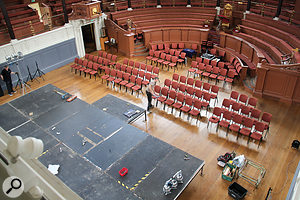 A stage had been brought in especially for the gig.
A stage had been brought in especially for the gig.
Reconnaissance Mission
I arrived a little early, and it turned out Philip had been entirely correct about the parking situation. There was nothing close enough for easy loading in and out, nor even any long–term parking within reasonable “I’ll go and move the van” distance.
When Philip arrived we met with the duty Theatre Manager who showed us around. The Sheldonian is one of those buildings which is even more impressive when you’re there in person than the many available photographs suggest. From a live–sound perspective, though, my heart sank when I walked into the main hall and heard the sound of visitors’ conversations bouncing off everything in sight, and saw the layers of balconies rising toward the roof. “Are you, um, going to have any audience up there?” was answered with “I certainly hope so,” and I began thinking about how I was going to achieve intelligible, warm and perfectly balanced sound coverage to the floor area and three layers above in what could fairly be called a pretty lively space.
The Sheldonian has no stage or anything like a proscenium, and the seating balconies curve around to face a flat wall below the organ loft. The hall looks about as high as it is long, and there is very little absorbent material anywhere — even the seats in the upper levels are wooden benches. Standing in the middle of the room and clapping, or saying “tsoo, tsoo” didn’t make my day any better, so we discussed practical things like where the mixing position would be, and where we would be able to locate the main speakers at floor level and on the balconies.
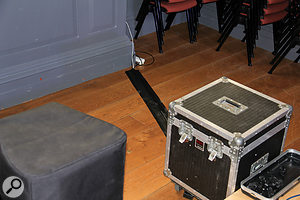 So as not to damage the antique floor, some Cable Path tape had been provided. This leaves no residue on removal, and has a non–sticky line down the centre so that cables can be pulled through after the tape has been stuck down.Philip told me that he was having a stage brought in, and we paced out cable runs to the mix point and located the mains power points. When I enquired about the use of gaffer and/or hazard tape, the manager produced a roll of specialist cable tape, which is much wider than the traditional stuff and leaves no trace after removal, but has good adhesion and a non–sticky part in the middle so that cables can be pulled through and adjusted after the tape has been stuck down — I call it ‘tunnel tape’ but I think its proper name is Cable Path. The Sheldonian were happy to supply as much as we needed, which was an excellent arrangement as it’s quite expensive stuff!
So as not to damage the antique floor, some Cable Path tape had been provided. This leaves no residue on removal, and has a non–sticky line down the centre so that cables can be pulled through after the tape has been stuck down.Philip told me that he was having a stage brought in, and we paced out cable runs to the mix point and located the mains power points. When I enquired about the use of gaffer and/or hazard tape, the manager produced a roll of specialist cable tape, which is much wider than the traditional stuff and leaves no trace after removal, but has good adhesion and a non–sticky part in the middle so that cables can be pulled through and adjusted after the tape has been stuck down — I call it ‘tunnel tape’ but I think its proper name is Cable Path. The Sheldonian were happy to supply as much as we needed, which was an excellent arrangement as it’s quite expensive stuff!
Calling For Backup
 Front–of–house engineer Dave Lockwood (left) and the Spooky Men’s Chorale’s touring engineer.I needed an acoustically-friendly crew for this gig, so I asked Dave Lockwood to team up with me. After considering the sound requirements along with the need for high–quality but visually low–profile main speakers and a restricted area for the console, we decided to use my JBL PRX635 cabinets for the front of house (possibly with another pair on the second balcony level or even three pairs to include the upper level if necessary), and we chose Yamaha DXR10 and DBR10 active speakers for the floor monitors. A Behringer X32 Compact got the nod for console duty, and as we only had to supply one mic for the leader/soloist spot we took along a choice of AKG C5 and Shure Beta 87, with a boxful of other capacitor mics just in case. I happened to have a pair of JBL Eon 612 speakers for review at the time, so I took them along in case we needed any extra fill.
Front–of–house engineer Dave Lockwood (left) and the Spooky Men’s Chorale’s touring engineer.I needed an acoustically-friendly crew for this gig, so I asked Dave Lockwood to team up with me. After considering the sound requirements along with the need for high–quality but visually low–profile main speakers and a restricted area for the console, we decided to use my JBL PRX635 cabinets for the front of house (possibly with another pair on the second balcony level or even three pairs to include the upper level if necessary), and we chose Yamaha DXR10 and DBR10 active speakers for the floor monitors. A Behringer X32 Compact got the nod for console duty, and as we only had to supply one mic for the leader/soloist spot we took along a choice of AKG C5 and Shure Beta 87, with a boxful of other capacitor mics just in case. I happened to have a pair of JBL Eon 612 speakers for review at the time, so I took them along in case we needed any extra fill.
In due course the get–in schedule was agreed, and I also received a valuable tip–off from the staging guys, who knew the venue and had been able to arrange private parking with the porters at Brasenose College. Stage lighting was being supplied by another local colleague, Martin Putman, and as we wouldn’t be needing lots of big speakers, we did a deal on combining transport and help with loading.
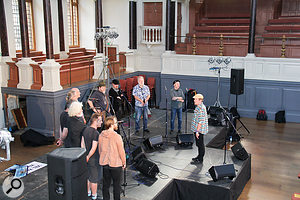 Soundcheck time! The monitors were arranged in a semicircle for the main choir, with another two wedges up front for the soloist.The get–in called for us to arrive for load–in at 1pm. When we arrived we saw the staging guys were still parked up outside the front entrance in Broad Street, so we nosed in behind and I went off to sweet-talk a traffic warden, who turned out to be very helpful and understanding. Loading in was one of those mingling–with–the–tourists affairs, carrying everything in relays from the van to the gate, then to the back of the building while we waited for access — not too bad overall, but the stage build was well behind, so we went in search of lunch.
Soundcheck time! The monitors were arranged in a semicircle for the main choir, with another two wedges up front for the soloist.The get–in called for us to arrive for load–in at 1pm. When we arrived we saw the staging guys were still parked up outside the front entrance in Broad Street, so we nosed in behind and I went off to sweet-talk a traffic warden, who turned out to be very helpful and understanding. Loading in was one of those mingling–with–the–tourists affairs, carrying everything in relays from the van to the gate, then to the back of the building while we waited for access — not too bad overall, but the stage build was well behind, so we went in search of lunch.
Stop, Spook, Listen
Rigging was straightforward on the ground level, following the Spooky plan of a semicircle of eight capacitor mics in the centre part of the stage with the lead/solo mic downstage centre. All cable routes had to be agreed by the theatre manager, who was really helpful, the only big ‘no–no’ being that on no account were we allowed to sit on the big throne seat — which was a shame, as it would have been an ideal position for mixing! As you can see from the pictures, the upstage DBR10 wedges were arranged one per voice to give the correct on–stage balance, with two DXR10 boxes at the front for the leader. The opening act on this occasion was Kirsty Bromley, an unaccompanied solo singer, and we planned to use the Chorale’s lead mic for her set.
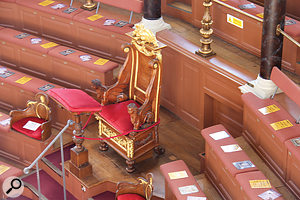 Sadly not the front–of–house mixing position...We were able to get the main system up and running at floor level, using a pair of JBL PRX635 cabinets on stands, to see what the coverage might be like with some vocal and recorded music — we used Spooky Men recordings, as it seemed the obvious thing to do. Against all expectations, the sound was remarkably consistent throughout the whole audience area, with a slight loss of intelligibiity and definition in the balconies, especially at the sides. Rather than rig a second set of forward–facing mains, we tried using outfills positioned just behind the left and right speakers, firing up at the balconies bleacher–style, and this improved everything to the point where we were confident that rigging anything more would not yield any further benefit. The other plus point for this setup was that the sound would always be perceived as coming from the stage itself, and as the room was so full of reflections, we should be able to achieve a ‘naturally reinforced’ result that would tie in with what the audience were seeing. The SMC’s tech rider describes their sound as being, and I quote: “rich and comfy like a male voice sofa,” which really does capture what they are all about!
Sadly not the front–of–house mixing position...We were able to get the main system up and running at floor level, using a pair of JBL PRX635 cabinets on stands, to see what the coverage might be like with some vocal and recorded music — we used Spooky Men recordings, as it seemed the obvious thing to do. Against all expectations, the sound was remarkably consistent throughout the whole audience area, with a slight loss of intelligibiity and definition in the balconies, especially at the sides. Rather than rig a second set of forward–facing mains, we tried using outfills positioned just behind the left and right speakers, firing up at the balconies bleacher–style, and this improved everything to the point where we were confident that rigging anything more would not yield any further benefit. The other plus point for this setup was that the sound would always be perceived as coming from the stage itself, and as the room was so full of reflections, we should be able to achieve a ‘naturally reinforced’ result that would tie in with what the audience were seeing. The SMC’s tech rider describes their sound as being, and I quote: “rich and comfy like a male voice sofa,” which really does capture what they are all about!
Check, One, Two...
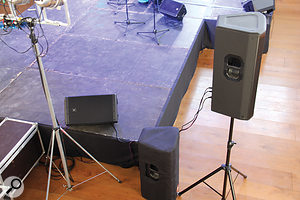 The side balconies were catered for by two supplementary speakers, one on each side of the stage, firing upwards.
The side balconies were catered for by two supplementary speakers, one on each side of the stage, firing upwards.
The SMC travel with their own sound engineer, but as he’s one of them and sings on stage, he gets involved mainly at the setup and early soundcheck stage. He advised Dave, made suggestions, and eventually approved what was happening at the console (see ‘On The Faders’ box), and so the group began running through numbers. As soundchecks go this was a very uncomplicated one once the ringing-out process had been completed and an acceptable balance achieved in the foldback wedges, as nothing really changes throughout the set other than very subtle balancing across sections, and of course the level on the lead mic. The two–on–a–mic layout worked well and assisted the natural sound, although care was needed as the mics were around 20cm from any individual Spooky Man and had something of an ambient quality.
With no musicians or even pre–recorded backing to worry about, and a group listening to each other all the time, this was the stuff live–sound dreams are made of, and the gig was ours to spoil. I learned long ago, in similar acoustic spaces, not to try and fight the room, especially when it’s devoid of audience, and I left Dave to carry on tweaking and consulting with the SMC sound guy while I roamed the entire venue listening for problem areas, coming back to make relative adjustments to the outfills until all was deemed to be good to go. We did connect a wireless router to the X32 for my iPad, but in the end we didn’t need to make any remote adjustments. Our final act of preparation was to use the fancy tape and make all our cabling safe and tidy before getting on with the show.
 Happily, the Spooky Men’s Chorale provide a detailed technical rider for all their shows.
Happily, the Spooky Men’s Chorale provide a detailed technical rider for all their shows.
Singing & Dancing
There’s not much to say about the running of the show itself, as Dave says in his notes, but I have to tell you that I enjoyed the performance more than anything I’ve heard for a very long time. The Spooky Men produce an inspiring sound, and the material is extremely funny — probably the first time I’ve seen the sound engineer shaking with laughter during a live set, and for all the right reasons... There was serious material in there too, which was simply inspiring; their version of ‘Crossing The Bar’ inspired me to make an arrangement for my own group of singers.
After the final number took audience participation in a somewhat unexpected direction and everyone departed in a happy state, we began removing the special expensive tape, which came up with no effort and left zero residue on the historic wooden floor. The get–out was easy enough, although the earlier organised serial approach gave way to the usual parallel one, with staging, lights and sound all packing and trying to load out at the same time in order to meet the strict 11pm out–of–the–door cut–off.
I think that the show was, from a live–sound angle, a great success because on the day we were blessed with those magic ingredients which so rarely come together: great talent on stage, a clear sound requirement, and excellent liaison between performers and crew. The Spooky Men’s Chorale and the Sheldonian Theatre are two satisfying and enjoyable items to add to the ‘done that’ list, and I hope that the gig comes round again.
On The Faders
 Showtime! In the event, the sound throughout the venue was excellent, with plenty of that all–important vocal intelligibility.A good vocal group — and the Spooky Men’s Chorale are certainly that — will always be self–balancing to a large extent, so I didn’t anticipate much in the way of fader riding for the eight main ‘backline’ mics. However, I guessed the handheld mic of the SMC’s frontman might need a fair amount of attention, and with the supplied set list/mixing guide calling for different reverb levels at various points throughout the set, the effects return faders would obviously see a bit of action, too.
Showtime! In the event, the sound throughout the venue was excellent, with plenty of that all–important vocal intelligibility.A good vocal group — and the Spooky Men’s Chorale are certainly that — will always be self–balancing to a large extent, so I didn’t anticipate much in the way of fader riding for the eight main ‘backline’ mics. However, I guessed the handheld mic of the SMC’s frontman might need a fair amount of attention, and with the supplied set list/mixing guide calling for different reverb levels at various points throughout the set, the effects return faders would obviously see a bit of action, too.
The X32 switches rapidly between its layers, so I anticipated no problem with keeping a simple ‘all inputs’ layout across the desk and flipping to the effects layer when I needed to. The challenging acoustic, plus the fact that we had rigged PA ‘outfills’ on either end of the stage to cover the high–banked seating at the sides, meant that it really only made sense for the front–of–house mix to be mono, with just the effects–return channels split left and right.
Ringing out the mains was a fairly brutal affair, as the plots of the eventual settings of the graphics would have shown, but the end result was a surprisingly docile FOH at performance level, considering the environment. The Spooky Men have their backline foldback zoned to favour the voices on the opposite side of the stage, which helped to keep the wedges very calm, too. With the graphic EQs doing their job well, we used no automatic feedback elimination.
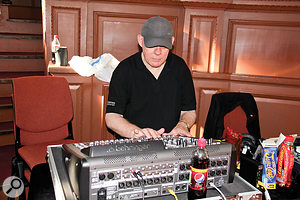 Dave Lockwood mixed the show using a Behringer X32 Compact console.The Spookies like to have a big cathedral–like reverb tail on the end of vocal phrases in some of their pieces. Dialling up something appropriate from the X32’s effects library, it immediately became apparent that when you are in an environment that pretty much sounds like that all the time, you struggle to hear ‘a bit more’ as any change at all. By the time we could hear an obvious lengthening of the tails, the system was already taking off into wide–spectrum feedback. An answer, of sorts, lay in switching to a reverb of a very different characteristic: a plate emulation, with a fast onset that you could hear in the gap before the venue’s own early reflections hit. This at least allowed the creation of an audible difference between ‘extra–long decay’ pieces and ‘normal’ pieces.
Dave Lockwood mixed the show using a Behringer X32 Compact console.The Spookies like to have a big cathedral–like reverb tail on the end of vocal phrases in some of their pieces. Dialling up something appropriate from the X32’s effects library, it immediately became apparent that when you are in an environment that pretty much sounds like that all the time, you struggle to hear ‘a bit more’ as any change at all. By the time we could hear an obvious lengthening of the tails, the system was already taking off into wide–spectrum feedback. An answer, of sorts, lay in switching to a reverb of a very different characteristic: a plate emulation, with a fast onset that you could hear in the gap before the venue’s own early reflections hit. This at least allowed the creation of an audible difference between ‘extra–long decay’ pieces and ‘normal’ pieces.
The soundcheck was relatively brief and primarily focused on system tuning and making everyone comfortable with their foldback. The opening act was a solo unaccompanied vocalist who requested that the foldback be switched off completely, so we really couldn’t be sure what we were going to get until we had all the Spooky Men on–mic at full performance level, with the wedges up as well. All was obviously fine once we were up and running, however, with our principal concern, the lyric intelligibility so important to an act of this type, proving not as much of an issue as we’d anticipated. The FOH mix position was at floor level (they wouldn’t let me mix from the Sheldonian’s elevated throne — I tried), but Mike’s scouting trips to the upper levels reported that the sound remained remarkably consistent throughout, so our pragmatic decision to not rig a separate balcony system was probably right.
I checked in with the performers at half–time, to see if there were any foldback tweaks wanted, resulting in just a request for a bit more in the stage–left wedge.
‘Mixing’ consisted of dipping the front–line handheld whenever it wasn’t in use, and gently favouring sub–sections of the singers by a dB or so whenever they were obviously carrying the principal part of a tune. They needed no more balance assistance than that. Dave Lockwood
